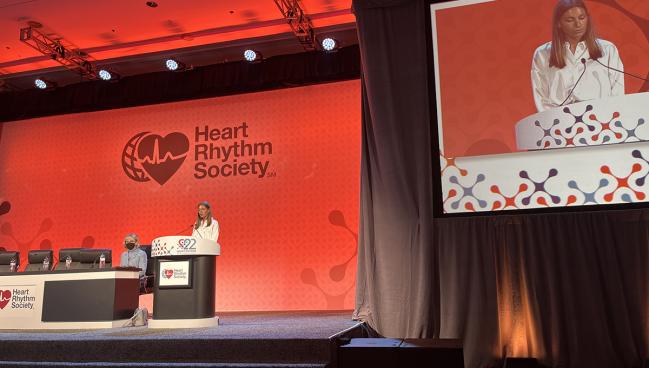Intensive BP Control May Stave Off LV Conduction Disease: SPRINT
The study suggests that cardiac conduction disease is not inevitable and could be prevented, a researcher says.

SAN FRANCISCO, CA—In the SPRINT trial, patients who were treated to an intensive versus standard blood pressure goal had a lower risk of developing LV conduction disease, which hasn’t been considered a preventable issue.
After adjustment, risk was a relative 26% lower with intensive treatment through a median follow-up of 3.5 years (HR 0.74; 95% CI 0.56-0.98), with a separation between trial arms occurring early after randomization, Katrine Emilie Frimodt-Møller, MB (University of California, San Francisco), reported here at Heart Rhythm 2022.
An advantage for treatment to the lower BP goal was consistent across subgroups and was still apparent in additional analyses that included new ventricular pacing as part of the outcome, and that considered all-cause death as a competing risk.
“These data suggest that a more-aggressive blood pressure treatment may be an accessible strategy to prevent left ventricular conduction disease and, moreover, that clinically important cardiac conduction disease is not inevitable among those that ultimately develop it, but rather that it is a modifiable outcome susceptible to prevention strategies,” Frimodt-Møller said during her presentation.
Discussant John Sapp, MD (QEII Health Sciences Centre, Halifax, Canada), said “this is new knowledge—that modifying blood pressure can affect the incidence of conduction disease.”
But that sparks a lot of questions about mechanisms, which could involve a mechanical effect on the ventricle, fibrosis that may or may not be related to neurohormonal modulation, or an inflammatory effect, he indicated, adding that hypertension might not be the only risk factor that can be modified to lessen the risk of conduction disease.
“Ultimately what we have is, I think, a new box opened [and there is] a lot of exploring to do,” Sapp said. “We should see the conduction system as a vulnerable structure in the heart. . . . Maybe we should now be thinking of the conduction system as something that we can protect, or should protect, and ultimately we’ll have to test that in randomized trials.”
Shifting the Focus to Prevention
Cardiac conduction disease can lead to syncope, heart failure, and death, and the only strategy for lessening its harm once it’s known is implantation of a permanent device, Frimodt-Møller said, pointing out that nothing has been proven to prevent it from developing in the first place.
Observational research has shown that hypertension is associated with LV conduction disease, including fascicular block and left bundle branch block (LBBB), providing a rationale for exploring whether more-intensive BP control could prevent it.
Maybe we should now be thinking of the conduction system as something that we can protect, or should protect, and ultimately we’ll have to test that in randomized trials. John Sapp
For the study, Frimodt-Møller and her colleagues turned to the SPRINT trial, which showed that treating to a systolic BP goal of less than 120 mm Hg versus a goal of less than 140 mm Hg reduced adverse clinical outcomes in nondiabetic patients with hypertension and a high cardiovascular risk. This analysis focused on the 7,874 participants (mean age 68 years; 64% men) who had sufficient ECG data and lacked LV conduction disease, a ventricular paced rhythm, and ventricular preexcitation at baseline.
During follow-up 203 patients developed LV conduction disease (116 who received standard treatment and 87 who received intensive treatment), which included left anterior fascicular block, left posterior fascicular block, LBBB, and nonspecific intraventricular conduction delay. More-aggressive BP control was associated with lower numbers overall across all of these categories, although there was only one case of left posterior fascicular block.
On multivariable adjustment, intensive treatment was associated with a lower risk of incident LV conduction disease, whereas older age, male sex, and clinical CVD correlated with an elevated risk.
Thinking About Mechanisms and Next Steps
Even though LV conduction disease was not a specified outcome of the SPINT trial, Gregory Marcus, MD (University of California, San Francisco), senior author of the study, said the fact that patients were randomly assigned to intensive or standard BP control should mitigate concerns about confounding that typically accompany observational studies.
Moreover, the researchers included right bundle branch block (RBBB), which is not expected to be affected much by systemic hypertension, as a negative control. And indeed, Marcus said, there was no significant relationship between the intensity of BP control and the development of RBBB.
There is a question, then, about the mechanism that would explain how lowering systolic BP prevents the development of LV conduction disease. And Marcus told TCTMD that it’s likely related to a reduction in the amount of wall stress when the left ventricle pushes against less pressure.
As for next steps in this area of research, Marcus indicated that more studies are needed identify which types of patients are most likely to benefit from more-aggressive BP control to prevent LV conduction disease. Subgroup analyses hinted that patients with heart failure had more to gain, but further research is required, Marcus said.
Taking a broader view of the study, Marcus said “we hope that it will shift the way we just think about and approach conduction disease,” adding that there’s no reason to think that hypertension is the only factor that can be modified to reduce risks. He noted that Frimodt-Møller would be presenting another study at the meeting showing that individuals who had higher levels of physical activity were less likely to develop conduction disease.
“There’s a lot of work yet to be done,” Marcus said, likening the situation to the early days of understanding that atrial fibrillation was preventable.
Todd Neale is the Associate News Editor for TCTMD and a Senior Medical Journalist. He got his start in journalism at …
Read Full BioSources
Marcus GM. Effect of intensive versus standard blood pressure treatment on incident left ventricular conduction disease. Presented at: HRS 2022. April 29, 2022. San Francisco, CA.
Disclosures
- Frimodt-Møller reports no relevant conflicts of interest.
- Marcus reports research grants from Baylis Medical Company; consulting fees from Johnson & Johnson, InCarda Therapeutics, and Medtronic; and equity in InCarda Therapeutics.
- Sapp reports honoraria or speaking/consulting fees from Medtronic, Biosense Webster, Abbott, and Varian Medical Systems and research grants from Abbott and Biosense Webster.





Comments